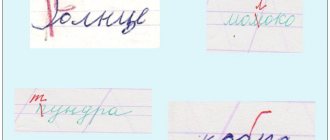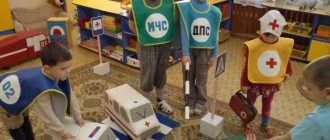Prevention of dysgraphia in preschoolers
When teaching preschoolers to read and write, parents should avoid common mistakes that can lead to reading and writing disorders in preschool children, dysgraphia and dyslexia.
What exercises should be done with a child to prevent the occurrence of dysgraphia?
Competent prevention of dysgraphia in preschoolers should be carried out in several areas:
- It is important before school and while learning to read to train the skills of sound analysis and synthesis. Failure to do so can lead to errors in writing and reading.
The child must master the concepts of “sound”, “letter”, “consonant”, “vowel”, “hard consonant”, “soft consonant”, “syllable”, “stress”, “word”, “sentence”.
The preschooler must find the differences between:
- letter and sound;
- vowel and consonant;
- word, syllable and sound;
- hard and soft consonants;
- voiced and voiceless consonants;
The future student should be able to divide a word into syllables, highlight a stressed syllable, and highlight the position of a given sound (or syllable) in a word.
Exercises to train sound analysis (phonemic analysis) should be done with all preschoolers in order to prevent the occurrence of dysgraphia due to disorders of language analysis and synthesis:
- Clap your hands when you hear the sound [O] and stamp your foot when you hear the sound [U].
- Arrange the pictures in two piles - on a blue and green field. Words that begin with soft sounds will be on the green field, those with hard sounds will be on the blue field.
- I will name the voiced sound, and you will name the paired unvoiced sound (B - P, D - T, etc.).
- I will call it hard, and you will call it paired soft (S - Sb, M - Mb, etc.).
- Voiced or voiceless? Put pictures whose names begin with a dull sound [P] in the house without a bell, and put pictures whose names begin with a voiced sound [B] in a house with a bell.
- Who has more? The one whose word card has the most syllables wins.
- Find words with the same first sound in the word.
- Find words with the same sound at the end of the word.
- If a child had problems with sound pronunciation and replaced one sound with another, it is necessary to correct the speech before you begin to teach the child to write and read. But it also happens that the sounds are corrected, but the child sometimes continues to confuse them! For example, before the baby used to pronounce the sound [S] instead of the sound [Ш], but the speech therapist made a hissing sound and everything seemed to be fine. But in some words, the child, as if out of habit, returns to the old pronunciation, and says “malys” instead of “baby”, or “kosmosh” instead of “kosmos”. It's funny, isn't it? Yes, but also dangerous! After all, this is how he will write.
Distinguishing sounds that the child mispronounced, confused and changed for each other should be well practiced in a variety of exercises to prevent dysgraphia:
- If you hear the sound [Ш], pick up its symbol (a picture symbolizing the sound, for example, a ball with air coming out of it), and if the sound [S] sounds, show its symbol (for example, a pump).
- Repeat the sounds after me, don’t confuse them: [Ш] [С] [С], [C] [С] [Ш], [Ш] [С] [Ш], etc.
- Raise the sound symbol [Ш] if you hear a word with this sound. If the word contains the sound [S], raise the sound symbol [S].
- Put pictures - words with the sounds [Ш] and [С] in different houses.
- When getting acquainted with letters, it is necessary to learn to call a letter by its sound analogue: [V] and not [VE] or [YY], [SH] and not [SHCHA] or [SHCHE], [L] and not [EL] or [EL] . Immediately teach your child to read each letter with only one sound that represents it . This will help teach reading. Otherwise, errors will appear in the letter associated with an incorrect, distorted sound image of the letter; the child will write instead of “vaza” - “veaza”, instead of “pike” - “schuka”, instead of “bow” - “lyuk”, because the child pronounces the name letters as 2 sounds. There will be confusion in the perception of letters and sounds of our speech.
If such a mistake was made by parents or a teacher (this also happens), perform exercises to prevent dysgraphia:
- Sound dictation. The adult names the letter (pronouncing them as one sound), the child writes.
- Visual dictation. An adult draws a letter on a board or piece of paper, the child writes it and pronounces it (only one sound denoting a letter): letter [Ш], letter [T], etc.
- Determine which letter is the first in the words and name it. An adult offers a set of 2-3 pictures, the names of which begin with the same sound. For example: fish, rudder, lynx - all words begin with the letter P (letter [P]).
- When learning to write (in block letters) before school, you need to do a lot of exercises to consolidate the correct image of the letter. It is necessary to teach the child not to confuse letters that have similar elements and not to turn them over, and to write each letter in the correct direction. The better a child remembers the image of a letter, the fewer mistakes he will make when writing.
Carry out exercises with your preschooler to prevent optical dysgraphia:
- Circle the letter;
- Blind a letter from plasticine, lay it out from counting sticks or rope;
- Complete the missing details;
- Cross out incorrectly written letters;
- Learn a poem about the letter.
- What letter will you get if you add details?
- What letter will you get if you remove the details?
- Draw a letter in the air.
- Compare 2 letters, how are they similar and how are they different?
Take the time to spend with your child before school. Teach your preschooler to read and write correctly. A large selection of manuals and games will help you make your classes interesting and rich. It is easier to prevent dysgraphia than to struggle with eliminating dysgraphia at school. And your efforts will be rewarded with good grades and success of your first grader.
Teacher-speech therapist Surgucheva S.N.
Dysgraphia (handwriting and written speech disorders)
Dysgraphia is a partial disorder of the writing process associated with insufficient formation (or decay) of higher mental functions involved in the implementation and control of written speech.
Dysgraphia is manifested by persistent, typical and repeated errors in writing, which do not disappear on their own, without targeted training and correction.
Corrective work to overcome dysgraphia requires the elimination of violations of motor skills, coordination, balance, attention, concentration, perception, as well as sound pronunciation, the development of phonemic processes, vocabulary, grammar, and coherent speech.
Mastering written language (reading and writing) requires balanced functioning of the whole brain. It is not surprising that dysgraphia (impaired learning of written language), dyslexia (impaired reading) and dysorthography are the main problems of schoolchildren around the world. The brains of many children cannot cope with processing information coming from the senses - vision, hearing, tactility, etc.
Advice to read more and write more usually does not bring results. Problems with reading and writing always have specific neurological causes; these dysfunctions force the brain to work in constant overload mode, which is why the child is often tired or, on the contrary, overactive.
An experienced teacher may notice that the student is clumsy, “turns a deaf ear” (as if he doesn’t hear), is restless, “counts crows,” is often distracted, and constantly fails to keep up.
However, the severity of these problems and their causes can be much more effectively identified by a neuropsychologist during neuropsychological diagnostics using special test tests and unique innovative devices.
Dysgraphia is a specific deficiency in writing caused by a violation of the HMF (higher mental functions) involved in the process of written speech.
The high prevalence of dysgraphia among schoolchildren is associated with the fact that about half of graduates of kindergartens and preschoolers enter the first grade with FPD or OPD, in the presence of which the process of full mastery of literacy is impossible.
This is a disorder that cannot be “outgrown”, it will not “resolve” on its own even in adulthood, it greatly spoils and complicates life, creates many psychological problems and complexes.
This is a disorder that can be “stopped” only with the help of neuropsychological correction quite quickly and effectively – once and for all; other methods only “clean up” the symptoms, temporarily easing their manifestation, but do not solve the problem as a whole!!!
Since writing and reading are inextricably linked, writing disorders ( dysgraphia, agraphia ) are usually accompanied by reading disorders ( dyslexia, alexia ).
Mastery of the writing process is closely related to the degree of formation of all aspects of oral speech :
- sound pronunciations,
– phonemic perception,
– lexical and grammatical aspects of speech,
- coherent speech.
The appearance of dysgraphia can be caused by underdevelopment or damage to the brain in the perinatal, natal, postnatal periods; dysgraphia can be caused by:
– pathology of pregnancy,
– birth injuries,
- asphyxia,
– meningitis
– encephalitis,
– infections and severe somatic diseases that cause depletion of the child’s nervous system.
Author: Malysheva Irina Stanislavovna
Position: Russian Federation, Tomsk, Tomsk State Pedagogical University. Master's student
Topic: Prevention of dysgraphia in older preschoolers with FFDD
Abstract: The article discusses methods for correcting FFND and preventing dysgraphia in children at risk.
Key words: Dysgraphia, FFNR.
The development of speech in preschoolers is one of the important conditions in preparing preschool children for school education. One of the main stages in the formation of grammatically correct oral and written speech is the prevention of dysgraphia in preschoolers - this is a partial disorder of writing processes caused by deviations from the norm in the activity of those analyzers and mental processes that ensure reading. Therefore, it is very important to identify even the most minor deviations in a child’s speech development and correct them before starting school, since any pathology is easier to prevent than to eliminate. It is now generally accepted that there is a close relationship between underdevelopment of oral speech and writing impairment. But as numerous studies by famous domestic defectologists (R.E. Levin, G.A. Kashe, N.A. Nikashin, A.K. Markov, L.F. Spirov, G.V. Chirkin, etc.) show, difficulties with Literacy learning does not occur in all children with pronunciation deficiencies, but only in those whose pronunciation deficiencies are an indicator of incomplete phoneme formation. This category includes children with phonetic-phonemic speech underdevelopment. The entire course of normal speech development of a child proceeds according to strictly defined patterns, in which each already formed link is a kind of base for the full formation of the next one. Therefore, the loss of one link (or a deviation from the norm in its development) interferes with the normal development of other links “built on top” of it. It follows that early identification of children with phonetic-phonemic underdevelopment and prerequisites for possible writing disorders and the elimination of these manifestations in them is a necessary condition for the successful correction of deficiencies in phonetic-phonemic underdevelopment in preschool age and the prevention of future writing disorders. The effectiveness of preparing children for writing is closely related to determining the optimal age for starting this work. L.S. Vygotsky therefore emphasized that only during certain periods does learning become easy and economical. Therefore, learning too late is just as difficult and ineffective as learning too early. Writing is a complex, multifaceted process that requires a fairly high level of development in children of coordinated hand movements and high precision of execution. The fifth year of life is considered the most sensitive age for the beginning of systematic work on children’s mastering graphic skills, which subsequently become the basis for elementary writing skills. Based on the analyzed literature (Efimenkova L.N., Nikashina N.A., Spirova L.F.), devoted to the problem of pathology of written speech in children, it shows that the elimination of deficiencies in reading and writing should be carried out comprehensively. Based on this, preventive work is also built. The first part includes areas of work that ensure the prevention of acoustic, articular-acoustic dysgraphia, dysgraphia based on violations of phonemic recognition:
– development of phonemic perception and phonemic representations;
-work on sound pronunciation;
-development of skills in language analysis and synthesis;
-development of syllabic analysis and synthesis;
-development of phonemic analysis and synthesis.
The second part includes areas of work that ensure the prevention of optical dysgraphia:
-development of visual perception;
-expansion of visual memory;
-formation of spatial representations;
-development of visual analysis and synthesis.
The third part includes the development of fine motor skills, since writing is a complex psychophysical process that requires a high level of development of fine motor skills.
It is important to consider that one of the conditions for effective interaction between children and adults is play activity. Play is the main activity of preschoolers. Play is an integral part of the formation and improvement of a child’s speech. Play in the process of preparing children 5-6 years old with FFND to master writing makes it possible to use a large number of different methods and techniques that increase children’s interest in this type of activity. Based on the above, the effectiveness of preventive work is closely related to the characteristics of speech disorders in children with FFDD; the work is complex and is implemented on the basis of play activities.
List of used literature 1. Bykova I.A. Teaching children to read and write in a playful way: Methodological manual. – St. Petersburg: DETSTVO-PRESS, 2006. 2. Levina R.E. On the genesis of writing disorders in children with general speech underdevelopment. Questions of speech therapy. - M., 1959. 3. Paramonova L.G. How to teach a child to spell. – St. Petersburg: “Delta”, M. : AST Publishing House LLC, 1997. 4. Paramonova L.G. Dysgraphia: diagnosis, prevention, correction. – St. Petersburg: DETSVO-PRESS, 2006. 5. Rostova N.N. On preparing children with developmental and behavioral disabilities for school. Speech therapy in kindergarten. - 2008. No. 1 (26).
www.Logopedy.ru
Speech therapist teacher: Antonets Natalia Valerievna. Saint Petersburg. GBDOU kindergarten No. 202
Preschool age is the most important period of personality development. The development of speech largely determines this process. By older preschool age, the child masters speech as a means of communication, cognition, and the development of various types of activities.
Among the many types of educational activities of a beginning schoolchild, mastering the skill of writing is one of the most important. The child’s success in further education largely depends on the degree of its formation, because writing integrates the mental, physiological, motor, and social functions of a person.
Dysgraphia is one of the most common speech defects in children of primary school age. This speech disorder negatively affects the entire learning process, school adaptation, and the formation and nature of the child’s entire mental development.
Difficulties in children learning to read and write existed before, but today they have become widespread. In the 50s XX century (according to Khvattsev M.E.) in public schools, about 6% of children with dysgraphia were observed. Today the picture has changed. Modern studies conducted in St. Petersburg show that in the second grade of a public school, 53% of children with dysgraphia were identified, 37% of children with this pathology enter the third grade into the fifth grade, and 39% enter the eighth grade (data published in the work of L. Paramonova .G. "Dysgraphia: diagnosis, prevention, correction. SPb. CHILDREN'S PRESS, 2006.). This, in turn, affects the literacy of an adult, i.e. develops into a social problem for society as a whole.
A number of studies from different years on this problem (Levina R.E., Kornev A.N., Lalaeva R.I., Paramonova L.G., etc.) confirm the opinion that writing impairment is based on a combination of dysfunctions, and namely: - oral speech defects; - insufficiently formed mental processes and their arbitrariness; - imperfection of visual perception; - awkwardness of fine motor skills.
Based on the above, it can be stated that children with FFDD are at risk of developing dysgraphia during school.
Thus, the prevention of dysgraphia in children of senior preschool age with FFDD is the most important area of work for a speech therapist .
The effectiveness of preparing children for writing is closely related to determining the optimal age for starting this work. L.S. Vygotsky therefore emphasized that only during certain periods does learning become easy and economical. Therefore, learning too late is just as difficult and unproductive as learning too early. The act of writing is a complex, multifaceted process that requires a fairly high level of development in children of coordinated hand movements and high precision of execution. The fifth year of life is considered the most sensitive age for the beginning of systematic work on children’s mastering graphic skills, which subsequently become the basis for elementary writing skills.
An analysis of the literature (Nikashina N.A., Spirova L.F., Efimenkova L.N.) devoted to the problem of pathology of written speech in children shows that the elimination of reading and writing deficiencies should be carried out comprehensively. Based on this, preventive work is also built.
The first block includes areas of work that ensure the prevention of acoustic, articular-acoustic dysgraphia, dysgraphia based on violations of phonemic recognition, namely: - development of phonemic perception and phonemic concepts; -work on sound pronunciation; -development of skills in language analysis and synthesis; -development of syllabic analysis and synthesis; -development of phonemic analysis and synthesis.
The second block includes areas of work that ensure the prevention of optical dysgraphia, namely: - development of visual perception; -expansion of visual memory; -formation of spatial representations; -development of visual analysis and synthesis.
The third block includes the development of fine motor skills, since writing is a complex psychophysical process that requires a high level of development of fine motor skills.
It is important to emphasize that one of the conditions for effective interaction between children and adults is reliance on play activities. Play is the main activity of preschoolers. Consequently, play communication is the necessary basis within which the formation and improvement of a child’s speech occurs.
Play in the process of preparing children 5-6 years old with FFND to master writing makes it possible to use a large number of different methods and techniques that increase the interest of modern children in this type of activity, such as jointly composing games, their variants, complicating already familiar exercises; figurative representation of graphic elements, various finger games, etc.
Thus, to summarize, we can state that the effectiveness of preventive work is closely related to the characteristics of speech disorders in children with FFDD; the work is complex in nature and is implemented on the basis of play activities.
List of used literature 1. Bykova I.A. Teaching children to read and write in a playful way: Methodological manual. – St. Petersburg: DETSTVO-PRESS, 2006. 2. Levina R.E. On the genesis of writing disorders in children with general speech underdevelopment. Questions of speech therapy. - M., 1959. 3. Paramonova L.G. How to teach a child to spell. – St. Petersburg: “Delta”, M. : AST Publishing House LLC, 1997. 4. Paramonova L.G. Dysgraphia: diagnosis, prevention, correction. – SPb.: DETSVO-PRESS, 2006. 5. Rostova N.N. On preparing children with developmental and behavioral disabilities for school. Speech therapy in kindergarten. - 2008. No. 1 (26). 6. Falkovich T.A., Barylkina L.P. speech development, Preparation for mastering writing. - M.: VAKO, 2005. Sender's address: 196603 St. Petersburg, Pushkin, Sapernaya st., 36, building 9, apt. 28 aantonec @mail.ru Original article in MS Word format
| If you liked this article, share the link to the article with your friends and acquaintances on social media. networks using this button | If you have your own special opinion about the material presented, leave your comment in the form below |
Social commentary Cackle
How to find out if a child has disorders?
Diagnosis of dysgraphia is carried out on the basis of the conclusions of a speech therapist, neurologist, ophthalmologist, and otolaryngologist. The child is asked to write a short dictation, rewrite text from a book, describe a picture, or read. The specialist evaluates the nature of the errors and, based on age, determines or does not determine the disorder.
Before 8–9 years of age the diagnosis is not made. From 6 to 8 years old, a student only masters writing skills and learns the rules. However, the prerequisites for dysgraphia can be visible much earlier, even in preschool age. Timely prevention helps prevent future violations.
When is prevention needed?
Preventive measures will not be superfluous for any preschooler. Special games and tasks will help prepare your child for school and make it easier to master written language.
But prevention is especially important for the following groups of children:
- children with speech therapy problems;
- children with ADHD;
- children whose parents suffered from dysgraphia and dyslexia at school age.
At an early age, the following symptoms may indicate possible disturbances in the structure of written speech:
- in kindergarten it is difficult for a child to learn poems and songs;
- he has difficulty repeating and reproducing rhythms;
- his movements are poorly coordinated (clumsy, awkward);
- does not like to draw and does it poorly (the lines are broken, not closed, the shading extends far beyond the edges);
- the child experiences difficulty in assembling construction sets and sculpting three-dimensional figures from plasticine;
- confuses the sounds B and P, K and T, S and Z, pronounces words illegibly and incorrectly;
- unable to concentrate on completing tasks due to age.
Correction of acoustic dysgraphia
It is very important that parents notice the existing problem in time and contact a specialist. It is quite possible to correct dysgraphia and help your child study successfully.
The speech therapist will diagnose the child’s speech condition and development. The fact is that manifestations of writing disorders are always secondary. It is necessary to identify the main cause of the condition and only then take corrective actions.
The lesson plan includes exercises that stimulate the development of phonetic hearing and perception, as well as sound analysis and synthesis. Considering that dysgraphia is usually diagnosed in school-age children, many tasks are carried out not in a game form, but in the form of doing exercises on paper. However, play moments should also be present so that the child does not experience fatigue and psychological stress.



